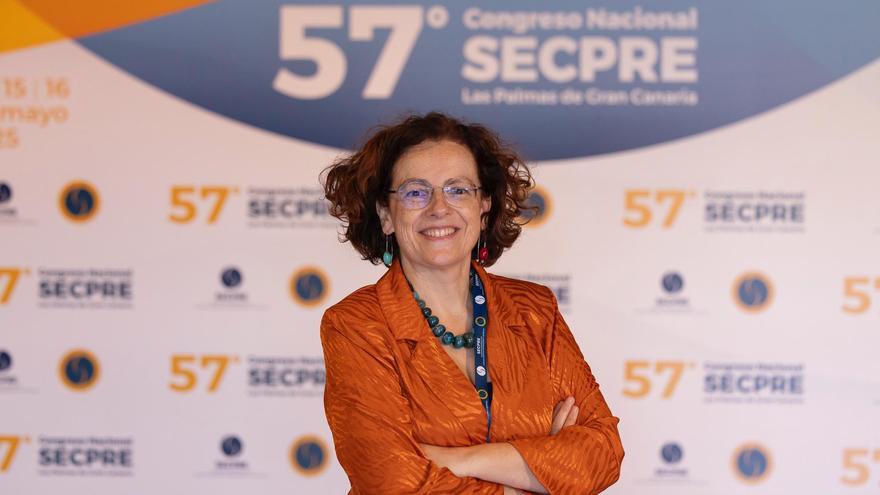
What are the key points of the intervention showcased at the congress?
Today, I took part in a regional panel featuring various plastic surgeons from the Canary Islands. Here, I addressed the surgical procedures related to breast cancer, specifically discussing breast removal surgery and the subsequent reconstruction performed by plastic surgery experts. Typically, oncological surgeries for this type of cancer are managed by general gynaecologists or surgeons; however, in this instance, we treat a group of patients who exhibit favourable clinical characteristics that permit breast removal and immediate reconstruction.
What benefits does this technique offer?
This procedure is known as skin-sparing mastectomy and, as its name suggests, it allows for the preservation of a significant portion of the skin, including much of the areola and nipple. This approach enables us to maintain a more natural appearance with fewer scars. During the panel, I shared our experiences at HUC, where we have been implementing this technique for the past three years. In total, we have performed surgeries on 42 women with a specific mutation. Tomorrow, I will join an international cooperation panel to present my experiences in Banjul, Gambia, where I have collaborated with a multidisciplinary team from Tenerife for the past four years.
What notable advancements have been made in breast oncological surgery in recent years?
Breast cancer is a condition that undergoes constant advancement and progress in terms of treatment. There is extensive research into this illness due to its high prevalence among women, leading to numerous clinical trials. Current trends focus on reducing surgical interventions for oncological conditions at the axillary level. Furthermore, from a reconstructive standpoint, there is a growing tendency towards autologous reconstruction, which utilises the patient’s own tissues without the use of implants. However, each reconstruction is influenced by various factors as each patient is unique and each case must be assessed individually.
Fortunately, surgeries are becoming increasingly conservative. However, when is a mastectomy necessary?
The transition from conservative surgery to more invasive options primarily relies on the histological characteristics of the tumour. Some tumours are sufficiently small to allow for only a partial breast removal, followed by radiotherapy. Additionally, the adoption of neoadjuvant chemotherapy—administered before surgery—has significantly aided in promoting conservative treatment, as it can reduce the tumour size, thus making mastectomy less necessary and the procedure simpler and less invasive.
What impact does mastectomy have on patients?
The breast is a highly symbolic part of a woman’s body, so undergoing a mastectomy can be profoundly disruptive to the self-image of these patients. While some women cope well, others struggle with it. This highlights the importance of ensuring that reconstruction is included as part of the treatment process to help them regain their former body image.
Thus, psychological support is crucial both pre- and post-surgery …
Absolutely. One in eight women will encounter breast cancer at some point in their lives—an alarmingly high statistic. This knowledge can somewhat ease the acceptance of their situation, as they are not alone; however, it remains a daunting fact. In my view, psychological support is essential for those who require it. In fact, we need many more psychologists and even psychiatrists to assist these women.
When is immediate reconstruction advisable and when should it be deferred?
In medicine, there are no absolute rules. Often, we choose to postpone reconstruction if the patient’s clinical situation indicates the need for radiotherapy. In such instances, it is preferable to wait until treatment is complete, then apply reconstructive techniques. However, this isn’t always the case as we sometimes perform certain flaps that are compatible with radiation. Therefore, a standard guideline is challenging to establish. It is clear that if the patient’s clinical circumstances do not denote curability upon the completion of all treatments, reconstruction should be delayed until such assurance is available.
What direction do you believe breast oncological surgery is headed?
The future of breast oncological surgery is likely to involve less extensive operations as medical treatments will increasingly take precedence, potentially sparing many patients from needing surgery in the future. Nonetheless, each case will require specific individual conditions, and each person will need the surgery appropriate to their needs. We must remember that there are three foundational pillars in addressing breast cancer: surgery, medical oncology—such as chemotherapy or immunotherapy—and radiotherapy.
How do you assess your experiences in Gambia thus far?
My first visit was in 2021. We collaborate with Edward Francis Small Teaching Hospital, a facility associated with the Faculty of Medicine in the capital. We typically visit for one week each year, with each team operating in three different surgical rooms. During this time, I perform numerous surgeries related to burns and their sequelae, surgeries on lower limbs, trauma procedures, as well as breast surgeries and urgent cases. Last year, our entire team conducted 47 procedures. The goal is to establish local training so that local doctors learn the techniques and can apply them themselves. This initiative is funded by Santa Cruz de Tenerife Hospital, and it has been immensely rewarding for me.
Why is this congress significant for plastic surgeons?
This congress holds great importance for us as it gathers hundreds of experts from across the country, representing both public and private healthcare sectors, facilitating the exchange of experiences and knowledge. All of this greatly enriches our daily practice.
















